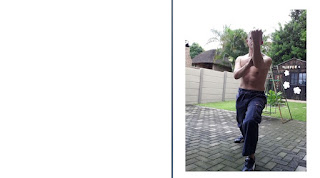The Defense Form
Hello, everyone and welcome back.
Today I introduce you to the form that appears in my book on Defense. If you have read the book before you may find it familiar. If not- it is still a good time to join us since I have begun posting breakdowns of the forms and their applications.
Although it is called the "Defense Form" for ease of reference the form does contain attacks.
Every block or sidestep here is shown with an attack that immediately follows it.
When I decided to document Wenhsiuquan techniques I have especially paid attention to this book, because much of the difference between Wenhsiuquan and its sources lies with defense.
Wenhsiuquan drew upon Karate, Kung Fu and Jujutsu. Jujutsu does have blocks and parries, although it is more known as a grappling art. Of these 3 martial arts Karate has the most blocks and parries that I know. I have not yet seen any Kung Fu forms, for instance that contain a rising forearm block (age uke). Sure- Shaolin Kungfu has an overhead block, but it is nothing like the one used in Karate.
Thing with Karate is, however, you often only see most of these blocks used in kata (forms) or in kihon (basic practice). The moment karateka get into free sparring they rather stick to simpler inward and outward blocks that require less movement.
Thing with Karate is, however, you often only see most of these blocks used in kata (forms) or in kihon (basic practice). The moment karateka get into free sparring they rather stick to simpler inward and outward blocks that require less movement.
This was one of the rules that I have made for blocking in Wenshiuquan- All blocks must consist of a single movement. The movement may be a straight line, a circle or any fraction of a circle, but it has to be one movement.
By simplifying blocking techniques I have managed to create blocks that can actually intercept an attack if body movement is not able to assist.
Blocking, is of course the last resort for defense and to be applied in the worst case scenario. This is why the form also features body movement and evasion.
When I started Karate I regarded defense as a matter of not getting hit.
I have since learnt, however, that if not getting hit is your only concern you will eventually get hit because the only thing that stops an opponent from trying to beat your defense is a decisive counterattack.
Wenhsiuquan is made to enable you to strike whenever an opening presents itself. When an opponent is already attacking, however- or when the only opening you may get will be when he attacks- Wenhsiuquan's defensive techniques enable you to reverse the situation and take over control of the fight.
Well- that is it for now!
See you next time when I start with the first move in the form!
Until then, train well and have a good week! :)
















Useful article, thank you for sharing the article!!!
ReplyDeleteWebsite bloggiaidap247.com và website blogcothebanchuabiet.com giúp bạn giải đáp mọi thắc mắc.